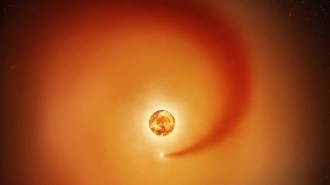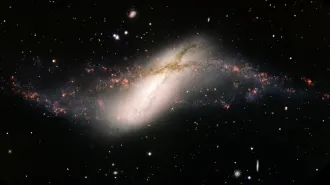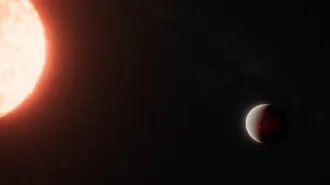Using the sharp X-ray eye of an orbiting observatory, astronomers have employed a novel method to measure distance within the Milky Way. If they can extend the technique to objects far outside our galaxy, it could yield a new estimate of the age of the cosmos.

The technique relies on the halo of radiation that surrounds objects that emit intense X rays. The halo arises as the X rays bounce off tiny dust grains lying between the object and Earth. These scattered X rays take slightly longer to reach Earth than those traveling directly. The delay for radiation coming from different parts of the halo, along with their apparent separation, indicates the distance.
Although researchers proposed the technique 27 years ago, X-ray observatories until now couldn’t image the halos in detail. Last July, NASA launched the Chandra X-Ray Observatory, which has 10 times the resolution of previous satellites. In October, Chandra examined Cygnus X-3, a neutron star orbiting a companion star every 4.8 hours. Because the companion periodically eclipses the neutron star, its X-ray emissions appear to flash on and off like a lighthouse beacon. This variability enables astronomers to detect a time delay.
Chandra imaged the halo around Cygnus X-3 and measured the delay—an average of 15 minutes—in the arrival of light from the halo as compared with that coming directly from the neutron star. The delay indicates that Cygnus X-3 lies about 30,000 light-years distant.
That number has a wide margin of error because the satellite only examined Cygnus X-3 for 3.5 hours. Nonetheless, the study demonstrates the power of the method, which relies only on geometry to gauge distance, says coauthor Peter Predehl of the Max Planck Institute for Extraterrestrial Physics in Garching, Germany. Previous distance techniques, he notes, have taken advantage of the dimming of light due to absorption by dust or atomic hydrogen, an effect that can be highly uncertain.
Predehl and his colleagues describe their work in an upcoming Astronomy and Astrophysics. The method promises to add “new knowledge about the structure, size, and shape of the Milky Way,” Predehl says.
In principle, notes Bruce T. Draine of Princeton University, astronomers could use the same method to calculate distances far beyond the Milky Way, if the variable X-ray source is extremely bright. This technique would be invaluable because researchers need such distances to determine the rate of expansion and age of the cosmos (SN: 10/8/94, p. 232).
Studying distant halos may require even sharper telescopes and much more information about dust between galaxies, cautions Predehl. Those studies “will certainly be much more difficult,” agrees Anthony N. Aguirre of Harvard University.







